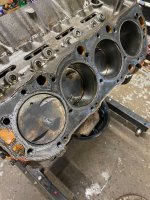MilkyNoSugar
CCCUK Member
First weekend where I could get some work done on the car following my knee surgery and the friends were available to help, and made reasonable progress before my knees started to complain.
The intake manifold and carb, and rocker covers were already removed. We got the alternator, water pump, bonnet, and radiator removed and oil drained. We took the rocker arms off, push rods and lifters out and moved the pipes and threaded studs over the new water pump.
First problem of the day was that the damper puller my friend said he would bring, was the wrong type so we could not get the timing cover off or cam out. Got a new puller on order along with a damper installation tool so we should be able to make progress when they arrive.
We then moved on to swapping the valve springs and seals that came with the rocker kit. We decided to try and do this with the heads in situ as the exhaust manifold bolts look like they have not been touched in 52 years and I do not want to make the job any bigger than it needs to be with a broken bolt in the head or block. Air line attached to the spark plug hole, and home made valve spring compressor deployed (waiting for a new one to arrive) we got the old spring removed. Second problem of the day was that the supplied valve stem seals were too small. The Inner Diameter of the ones we took off is approx 15mm, the new ones are only 12mm. There was no mention of needing to modify the valve stems, but from the research done this looks like what we are supposed to do. Have I missed something obvious here?

The intake manifold and carb, and rocker covers were already removed. We got the alternator, water pump, bonnet, and radiator removed and oil drained. We took the rocker arms off, push rods and lifters out and moved the pipes and threaded studs over the new water pump.
First problem of the day was that the damper puller my friend said he would bring, was the wrong type so we could not get the timing cover off or cam out. Got a new puller on order along with a damper installation tool so we should be able to make progress when they arrive.
We then moved on to swapping the valve springs and seals that came with the rocker kit. We decided to try and do this with the heads in situ as the exhaust manifold bolts look like they have not been touched in 52 years and I do not want to make the job any bigger than it needs to be with a broken bolt in the head or block. Air line attached to the spark plug hole, and home made valve spring compressor deployed (waiting for a new one to arrive) we got the old spring removed. Second problem of the day was that the supplied valve stem seals were too small. The Inner Diameter of the ones we took off is approx 15mm, the new ones are only 12mm. There was no mention of needing to modify the valve stems, but from the research done this looks like what we are supposed to do. Have I missed something obvious here?

Last edited:









